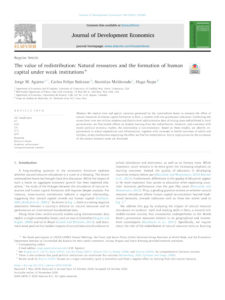The value of redistribution: Natural resources and the formation of human capital under weak institutions
| Year | : | 2020 |
|---|---|---|
| Author/s | : | Jorge Aguero, Carlos Felipe Balcázar, Stanislao Maldonado, Hugo Ñopo |
| Area/s | : | Education and learning, Employment, productivity and innovation |
Researchers exploit time and spatial variation generated by the commodities boom to measure the effect of natural resources on human capital formation in Peru, a country with low governance indicators. Combining testscores from over two million students and district-level administrative data of mining taxes redistributed to localgovernments, they find sizable effects on student learning from the redistribution. However, and consistent withrecent political economy models, the relationship is non-monotonic. Based on these models, the authors identify improvements in school expenditure and infrastructure, together with increases in health outcomes of adults andchildren, as key mechanisms explaining the effect they find for redistribution. Policy implications for the avoidance of the natural resource curse are discussed.






